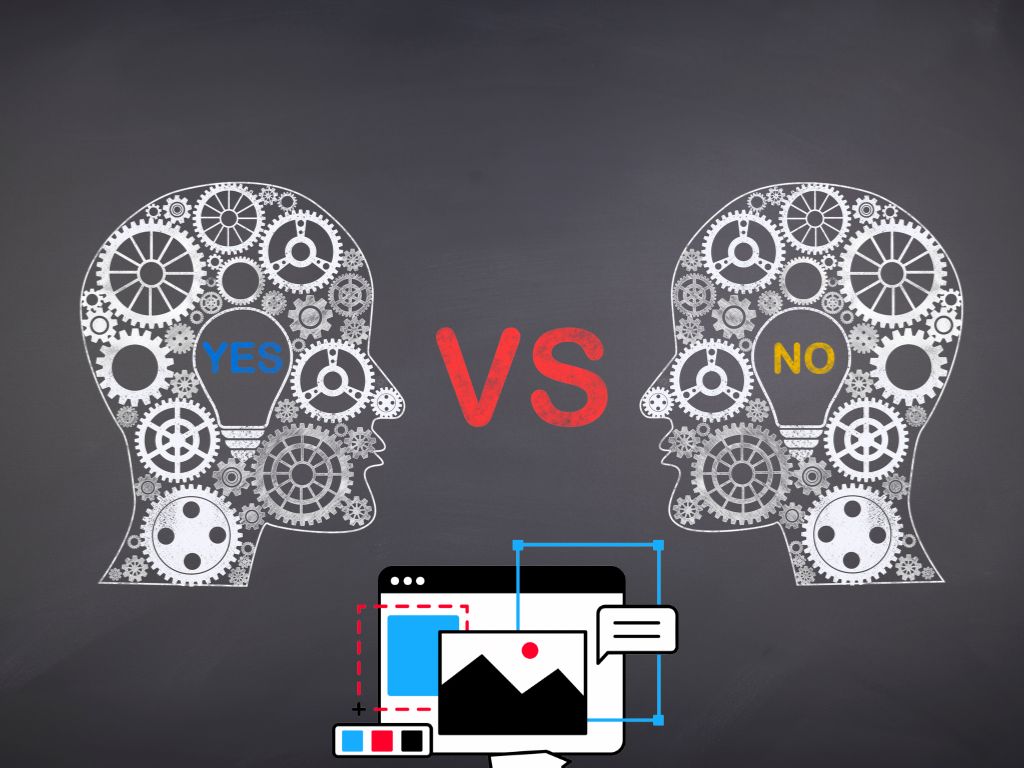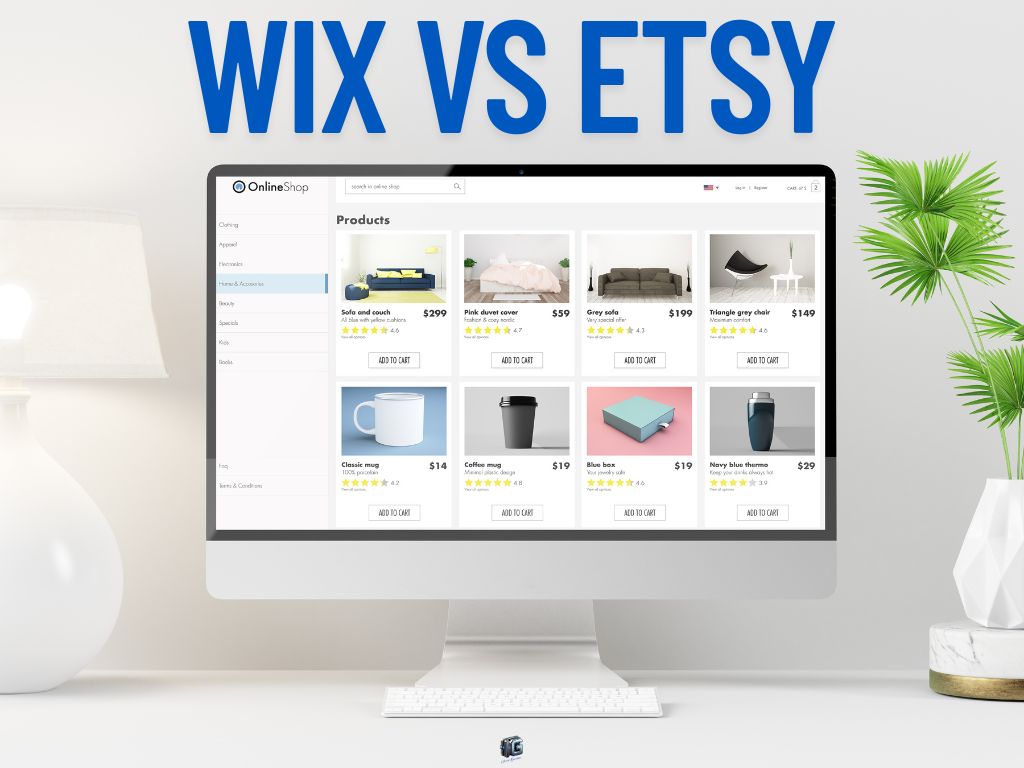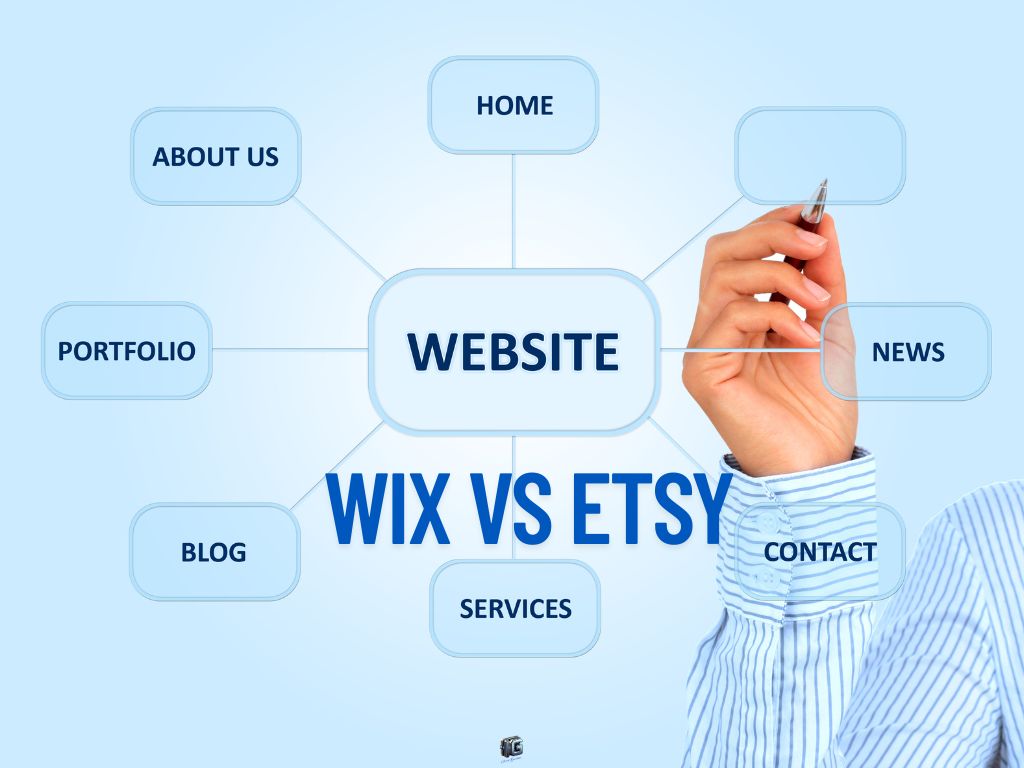If you’re ready to start making money online, chances are you’ve looked at Wix and Etsy and you’re wondering which one’s actually worth your time.
They sound similar. Both let you sell products online. Both claim to be beginner-friendly:
But here’s the truth: they’re completely different business models and picking the wrong one could choke your growth before it even starts.
Etsy gives you built-in traffic… but zero control.
Wix gives you total freedom… but you’re on your own when it comes to customers.
So which one’s better for making real money in 2025?
That depends on what you’re selling, how you want to grow, and how much control you want over your brand, pricing, and profits.
In this guide, you’ll get a brutally honest breakdown of Wix vs Etsy so you can stop guessing, skip the hype, and choose the platform that actually matches how you want to make money online.

Key Takeaways
- Wix gives you complete control over your store, brand, and customer experience
- Etsy brings instant traffic, but limits how you sell, price, and grow
- Wix is better for sellers who want full ownership and long-term scalability
- Etsy works best for beginners looking for quick exposure and easy setup
- Profit margins are typically higher with Wix, but Etsy reduces the barrier to entry
- Choosing the right platform depends on how you want to grow, not just how fast you want to start
What Is Etsy? (And Who Is It For?)
Etsy is a massive online marketplace built for selling handmade goods, vintage items, and digital products with a unique or niche appeal.
You don’t build a website on Etsy, you open a shop within their platform. It’s more like renting a stall at a bustling digital market than owning a storefront.
That’s what makes it attractive: Etsy already has millions of shoppers looking for specific products.
You don’t have to drive traffic or set up a site. You just list your product, and if it fits the search, you show up.
But here’s what most beginners don’t realize:
You don’t control the rules. Etsy owns the platform, the traffic, and the customer relationship.
You pay to list, to sell and to get found.
Etsy is ideal for sellers who:
- Want to launch quickly without building a full site
- Are selling handmade, craft-based, or trending physical products
- Prefer traffic provided by the platform rather than building an audience from scratch
- Are testing a product idea before committing to a full ecommerce setup
But that ease comes with limits: Your brand is secondary to Etsy’s. You don’t own your customer data. And your growth is capped by their algorithm, not your ambition.
Etsy is fast but it’s not flexible.
Wix vs Etsy: Side-by-Side Breakdown
If you’re still unsure which platform makes more sense for your goals, this breakdown makes it clear.
Each platform has strengths. Each has limits. The better choice depends on how much control you want and how much work you’re willing to put in.
Side-by-Side Comparison:
| Feature | Wix | Etsy |
| Setup Difficulty | Moderate build your own site | Easy open a shop within minutes |
| Traffic Source | You drive all traffic | Built-in marketplace traffic |
| Customization | Full control over design and layout | Limited customization, follows Etsy branding |
| Customer Ownership | You own the customer and email list | Etsy controls buyer data |
| Fees | Monthly plans + transaction fees | Listing fees + transaction + ad fees |
| Best For | Long-term brand builders | Quick-start sellers and trending niches |
| Scalability | High you own the platform | Limited growth depends on Etsy algorithms |
| Profit Margins | Higher no marketplace cuts | Lower platform takes a portion of sales |
| Product Types | Physical, digital, services, memberships | Primarily physical and digital products |
| Marketing Tools | Built-in email, SEO, ads, automation | Minimal control, optional Etsy ads |
Wix gives you freedom but demands strategy.
Etsy gives you speed but takes a cut of everything.
The best platform isn’t just the easiest to start. It’s the one that aligns with how you want to grow and what kind of business you’re building.
Wix vs Etsy: Fees, Profit Margins, and Control
Here’s the part most beginners skip and later regret:
Just because a platform is easy to use doesn’t mean it’s built to make you money.
Let’s talk about what really affects your bottom line: fees, margins, and ownership.
Etsy’s Fee Stack
Etsy feels cheap at first. Just $0.20 to list a product? Sounds great.
But once the sales roll in, here’s what you’re really paying:
- Listing fee: $0.20 per item
- Transaction fee: 6.5% of the sale price
- Payment processing: ~3% + $0.25
- Optional Etsy Ads: you pay per click, with no guarantee of conversion
- Offsite Ads (automatic for high sellers): Etsy keeps 12–15% of the sale if they drive traffic
The result? It’s common to lose 15–25% of every sale to platform fees.
And since you don’t control pricing tiers, checkout flow, or upsells, increasing margins isn’t easy.
Wix’s Flat Cost, Higher Profit Ceiling
Wix charges a monthly fee to run your store. Plans typically range from $17–$35/month for ecommerce features.
On top of that, you’ll pay standard payment processing (2.9% + $0.30 via Stripe or PayPal).
But here’s the difference:
- No listing fees
- No forced ad programs
- No cut taken from each sale
- No restrictions on what you can charge, bundle, or upsell
You keep more of every sale especially as volume increases. And you’re not at the mercy of someone else’s algorithm deciding if you get seen.
Control = Long-Term Profit
Wix gives you ownership. You control the:
- Pricing
- Design
- Sales funnel
- Email capture
- Customer relationship
Etsy gives you reach, but keeps the power. You rent space, play by their rules, and hand over a chunk of every sale even if you bring your own traffic.
So while Etsy may help you make money faster…
Wix gives you more control over how much you keep.

Traffic: Built-In vs Build-It-Yourself
Wix and Etsy are fundamentally different when it comes to traffic and that changes everything about how you grow your store.
Etsy: Instant Exposure, But No Guarantees
Etsy brings the audience to you. It’s a marketplace built on search traffic. Shoppers go there intending to buy, and your listings can show up right away.
That’s the advantage:
- You don’t need to learn SEO, run ads, or build a following
- Discovery is baked into the platform
- Your products appear alongside other sellers in categories, search results, and recommendations
But there’s a trade-off.
You’re one of thousands competing for visibility in the same marketplace.
You have limited control over how and when your listings show up. Etsy controls the algorithm, and your shop is just one part of their ecosystem.
When Etsy updates its rules or shifts its priorities? You feel it.
And good luck building long-term traffic if you’re relying on their platform to do it for you.
Wix: You Own It, So You Build It
Wix gives you zero traffic by default. No built-in marketplace. No automatic visitors. It’s just you, your store, and the internet.
That sounds like a disadvantage until you realize what it gives you:
- You’re not competing with thousands of similar listings
- You control your own marketing strategy
- You can drive traffic through SEO, Pinterest, social media, email, or ads
- Every visitor you get is your visitor not Etsy’s
The result? Slower start, but higher ceiling. With Wix, the more traffic you bring in, the more control and profit you keep.
You’re not fighting for scraps in someone else’s feed. You’re building an audience that belongs to you.
If you want fast, Etsy delivers exposure. If you want sustainable growth, Wix lets you build it.

Wix vs Etsy: Which Platform Is Better for Digital Products?
If you’re selling digital downloads like eBooks, templates, courses, printables, or guides your platform choice matters more than you think.
Because while both Wix and Etsy technically support digital products, only one of them gives you the tools to scale them.
Etsy: Fast Launch, But Limited Control
Etsy makes it easy to sell digital files. You upload your product, and buyers can instantly download it after purchase.
It’s simple. It works. And it’s beginner-friendly.
But beyond that? You’re boxed in.
You can’t:
- Offer upsells or bundles
- Capture email addresses automatically
- Build a content funnel or redirect traffic to your brand
- Control the delivery experience
You’re stuck within Etsy’s checkout system and if you want to grow beyond “one sale, one file,” it gets clunky fast.
Wix: Built for Full Control and Scalability
Wix gives you everything Etsy doesn’t. You can:
- Sell individual files or digital bundles
- Create custom checkout flows
- Automate product delivery via email
- Add email opt-ins before or after purchase
- Build lead magnets, tripwires, and funnels
- Set up gated content or digital memberships
In short: you’re not just selling a file you’re building a digital product business.
Yes, Wix takes longer to set up. Yes, you’ll have to drive your own traffic.
But once it’s running, it’s yours. No restrictions. No platform middleman. And no one deciding how you get paid or what you can charge.
If you want to test a product fast? Etsy wins.
If you want to scale a system that prints passive income? Wix dominates.
When You Should Start with Etsy
If you want to get up and running fast with minimal setup and no marketing experience, Etsy is the easier starting point.
It’s made for sellers who don’t want to build a website, learn traffic strategies, or deal with complex tech. You create a product, upload it, and start selling inside a marketplace that already has buyers.
Etsy is a strong fit if:
- You’re selling handmade goods, physical crafts, or unique printables
- You want to validate a product idea without investing in a full storefront
- You don’t have an audience or marketing strategy (yet)
- You want to make your first few sales with low upfront effort
- You prefer to focus on creating, not driving traffic
But the keyword here is starting.
Etsy gets you in the game quickly but it’s not built for long-term control or deep profit margins. You’re always playing by someone else’s rules, and your growth is tied to their algorithm.
If that’s a trade-off you’re okay with right now, Etsy can help you launch and prove that your product has potential.
When You Should Start with Wix
If you’re building more than a hobby if you’re building a brand, Wix is the better place to start.
Wix gives you full control over your site, your products, your pricing, your design, your email list, and your customer experience. There’s no marketplace dictating your visibility or cutting into your profits.
Wix is the right choice if:
- You’re selling digital products, services, memberships, or high-margin physical goods
- You want to own your traffic and build long-term SEO or social media strategies
- You plan to upsell, cross-sell, or run marketing funnels
- You want to scale without platform restrictions
- You’re focused on building something sustainable not just selling what’s trending
It takes more effort up front.
But what you build is yours not rented space in someone else’s platform.
Wix is for creators who are serious about business, not just side hustle momentum. If you’re in this for the long game, Wix lets you play it on your terms.
Can You Use Both? (Yes, Here’s How)
Wix and Etsy serve different purposes but if you understand their strengths, you don’t have to choose one forever.
Many sellers start on Etsy for exposure, then transition to Wix for growth.
Here’s how that works:
- Validate your product on Etsy
Use Etsy’s built-in traffic to test what sells. Pay attention to your bestsellers, pricing sweet spots, and real customer feedback.
- Build a brand on Wix behind the scenes
While Etsy brings in buyers, use Wix to create a branded store that you fully control your own site, your own checkout, your own email list.
- Capture traffic from Etsy and redirect it
Include packaging inserts, email opt-ins, and “thank you” pages that point customers to your Wix store. Now you’re building long-term traffic from short-term exposure.
- Shift your marketing to your own platform over time
As your Wix site gains SEO traction or social media visibility, you can rely less on Etsy and stop paying marketplace fees.
Using both isn’t about doing more work. It’s about doing smart work that compounds.
Etsy helps you start. Wix helps you scale.

Frequently Asked Questions (FAQs)
Can I sell digital products on both Wix and Etsy?
Yes. Both platforms support digital downloads. Etsy is better for launching quickly, but Wix gives you more flexibility to scale, upsell, and automate delivery.
Wix vs Etsy: Which platform is cheaper for beginners?
Etsy feels cheaper upfront with pay-as-you-go fees, but takes a larger cut per sale. Wix has monthly costs but gives you higher profit margins and long-term savings if you’re making consistent sales.
Do I need marketing skills to use Wix?
Yes. Wix doesn’t come with built-in traffic. You’ll need to learn or apply basic strategies like SEO, Pinterest, or email marketing. The upside? You own the traffic and the customer.
Can I migrate from Etsy to Wix later?
Absolutely. Many sellers start on Etsy to test products, then build a Wix store once they’re ready to grow. You can direct Etsy customers to your new site and gradually shift your marketing.
Wix vs Etsy: Which platform is better for building a brand?
Wix. You control the entire experience your domain, your design, your email list, your upsells. Etsy prioritizes the marketplace and limits your branding control.

Conclusion
Wix and Etsy both let you sell online but that’s where the similarity ends.
Etsy gives you speed. It gets you in front of buyers fast. Wix gives you ownership. It puts you in control of the entire business.
If you’re launching a handmade product, testing a niche, or just want to make a few quick sales without the hassle of building a website, Etsy gets the job done.
But if you’re playing the long game if you care about brand, margins, email lists, and building something that lasts, Wix gives you the tools to scale.
Don’t just ask which platform is easier. Ask which one actually supports the business you want to build.
That’s the difference between selling and growing.
If you’re leaning toward Wix because you’re selling digital products or services, there’s another battle worth seeing, Stan Store vs Shopify. Both platforms are built for creators, but take completely different approaches to selling online.
1 Comment
Stan Store vs Shopify: Creators, Read This First! - Ismel Guerrero. · April 17, 2025 at 10:32 pm
[…] Check out our Wix vs Etsy guide for a direct look at marketplace speed vs full […]